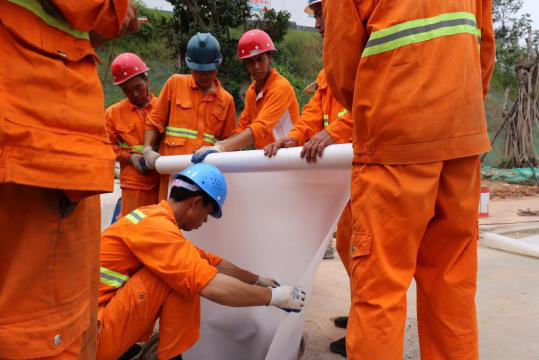UV Light-cured CIPP renewal technology is one of the CIPP technologies. It is proven to be stronger and longer lasting compared to felt lining or fold & form liners. With liner, a felt tube saturated with resin is inserted into the pipe via inversion or the pulled-in-placed method of installation. After the liner is in place, a suitable UV light source is required to cure the pipe liner.

Technical advantages
CIPP technology allows for the rehabilitation of damaged underground wastewater and storm sewer pipes without excavation. The process minimizes disruption to the public by reducing noise, traffic disturbance, and road damage—and can be done within a far shorter time frame, and usually for less cost than replacement.
The CIPP process is highly cost effective compared to traditional pipe replacement, with a realized cost savings of 40 to 50 percent. In some cases, the cost variance alone is a determinant as to whether or not a water or sewer system gets renewed.The CIPP lining installation rate is five times faster than full pipe replacement. Crews maintain a small, efficient construction footprint at project sites, which helps to significantly reduce public inconvenience and environmental impacts.
One of the most value-added benefits for our customers is the increased protection of persons and property within their communities. Since CIPP lining is completed underground, from manhole to manhole, it greatly reduces the risk associated with traditional pipe replacement.
Operation diagram of UV Light-cured CIPP renewal technology

Process description
The composition and structure of specially designed glass fiber reinforced lining hose have become the preferred technology for trenchless pipeline repair due to its superior performance and economic and ecological advantages.
The hose used for UV Light-cured CIPP repair technology is composed of inner membrane, glass fiber resin layer, outer membrane and protective membrane. After curing by ultraviolet light, the flexible modulus of the material can be up to 17000MPa, and the friction coefficient of the inner surface can be down to 0.009, which has a smaller structural wall thickness and a greater flow capacity than that after the repair by thermal curing process.
In addition, the technology does not produce waste water and pollute the environment in the process of renovation. The fastest curing speed is up to 1m/min. The whole process is visible, convenient for quality control and high safety.
Scope of application
Structural repair of collapsed pipeline after pretreatment
Internal enhancement of broken and leaking pipes
Repair of the pipe that causes structural damage
Pipeline maintenance
Technical process
1.

2

3

4.



Consequence Introduction
Case 1:Renewal case of DN 600 pipeline
Before

After

Case 2:Renewal case of DN 1200 pipeline
Before

After


